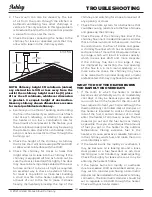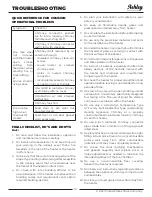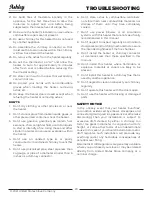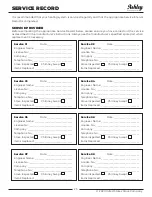
18
© 2021 United States Stove Company
2. The vacuum can also be caused by the loss
of air from the room through the kitchen or
bathroom ventilating fans, other chimneys or
vents, etc. The only solution to this type problem
is to reduce the air lost from the room or provide
a source for air to enter the room.
3. Check the pipes connecting the heater to the
chimney for loose or unsealed joints that may
allow air to leak into the chimney system.
NOTE: Chimney height 3ft minimum (unless)
any obstruction is 10ft or less away from the
outlet then chimney height must be (X) pluse
2ft or the eft minimum, whichever dimension
is greatest. X exquals height of obstruction.
Masonry chimney shown dimensions are same
for metal prefabricated chimney.
4. Examine your method of building and tending
the fire in the heater. If you add too much fresh
coal at each refueling, or attempt to operate
the heater at too low a combustion rate for
the amount of coal present in the firebox, your
failure to follow proper practices may be causing
the problem. Also check for ash buildup in the
ash pan. Ashes can restrict air flow through the
burning coal.
5. Check the height of the chimney. A chimney
that is too short will not develop sufficient draft
or allow wind to interfere with the draft.
6. Check the chimney for cracks or holes that
might allow air to leak into the chimney. If the
chimney is equipped with an ash clean out, be
sure the door is closed and fits tightly. The door
may have to be temporarily sealed with tape or
furnace cement to be as air tight as required.
An excellent way to check an exterior chimney
for leaks is to preform a smoke test building
a small coal fire in the heater, adding a small
amount of coal to the fire to make it smoke
heavily, momentarily blocking the top of the
chimney, and watching for smoke to leak out of
any opening or cracks.
7. Check the entire system for obstructions that
could be causing resistance to the flow of smoke
and gases up the chimney.
8.
Check the size of the chimney flue liner. If the
chimney flue liner’s inside dimension is smaller
that 6 inches round or 8 inches square, it will be
too restrictive to the flow of smoke and gases.
A chimney flue liner which has an inside cross-
sectional area of more that 85 square inches is
too large, which will result in excess capacity,
which means less draft and more creosote.
If the chimney flue liner is too large, it may
be improved by restricting the top opening
of the flue to a 6 inch round opening, or in
more extreme cases, the chimney may have
to be relined with a smaller lining and a metal
prefabricated chimney may have to be replaced.
WHAT TO DO IF THE HEATER BURNS
TOO RAPIDLY OR OVERHEATS
1. If the room in which the heater is located
becomes uncomfortably warm on moderately
cool days, it may be because you are placing
too much fuel in the heater for the amount of
heat required to heat your home. Although the
thermostatically controlled inlet air damper on
the heater is intended to control the burning
rate of the fuel, a certain amount of air must
enter the heater at all times to assure the fire
does not go out and the fuel burns as cleanly
as possible. Thus you should adjust the amount
of fuel you put in the heater to the outdoor
temperature. Placing excessive fuel in the
heater will cause excessive creosote formation
in the chimney, waste fuel, and make the room
uncomfortably warm.
2. If the heater burns too rapidly or overheats, it
may be because air is leaking around a loose
door gasket or a fuel feed door or ash door
latching pawl and handle may need adjusting.
Check thoroughly for leaks where air may be
entering the heater’s firebox.
3. If the heater burns too rapidly or overheats
due to excessive draft as described earlier, you
may wish to consider purchasing a barometric
damper top be installed in the heater’s chimney
connector. The barometric damper should be
set to regulate a .06 draft through the heater.
Check with your heater dealer.
TROUBLESHOOTING







































